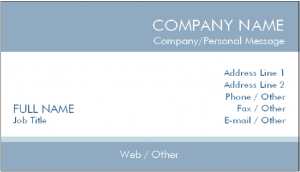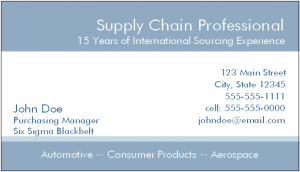Business cards sit on the desks and are carried in the wallets of almost all professionals. As common as beaming contact information from one PDA to another has become, the simple business card is an invaluable tool. A business card provides an extremely easy way to give your contact information to someone that wants to follow up.
For the employed, carrying business cards is routine. When you lose your job, the contact information on the card is no longer useful. What do you do?
First, try to keep copies of your resume on hand. Put a folder with a few copies in your car and take extra copies to networking events and other meetings.
There are times when you can’t take a resume with you – dinner with friends, church functions, sporting events, and other social situations, for example. These events are also some of the best places to network and get help with your job search. People that know you are more likely to help you.
So, what do you do if you are at a picnic and meet a friend of friend that offers to help you get an interview with a local company? You will want to get the individual’s contact information so you can follow up, and you will want to provide your contact information to them. This is where the business card comes in.
Design
Business cards for job seekers need to be professional. Stick to basic designs. Graphics may look pretty but may not reinforce the professional image you want to create. The exception to this is in the artistic fields. A graphic designer should express their creativity on their business cards and resume in ways that would be completely inappropriate in other professions.
Provide full contact information. You need your name, address, phone number, cell number and email address. Make sure you have a professional email address. If your personal email isn’t appropriate, get a free gmail account for your job search.
Most business card designs leave room for a few other lines of text. Usually, this is taken up with the company name, job title and company slogan. You can use these fields to brand yourself with keywords related to the position you are seeking. Below is a template and sample of a design from VistaPrint.
Buying Cards
You can get business cards a number of places. Online, VistaPrint will print 250 business cards for free, charging only shipping (between $5.45 and $25.19 depending on how fast you want your order). The free cards include a VistaPrint logo on the back. For a few dollars, you can have them printed without this. There are a lot of printers that can do business cards for you and a number of them have free offers similar to VistaPrint – so look around for the one that suits you best.
You can find a local printer to do your business cards. The cost may be a little higher, but you will have more control over the design and may get a faster turnaround.
You can also try printing your own business cards. Avery and other label makers provide card stock for business cards allowing you to print your own cards at home. You can get these at most office supply stores.
Expectations
What can you expect from your new business cards? That depends on what you do in your job search. If you go to a lot of social and networking events, you will end up giving out more cards. Of course, giving out a card with your contact information isn’t going to land an interview by itself. If that’s all you needed to do, you could go to the mall or a parking garage and put your resume on every windshield.
What the business card will do for you is give you a tool to allow you to take advantage of a chance meeting. You may not have any chance meetings requiring a business card like this, or you could have dozens. The important thing is being ready if you do.

